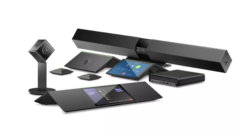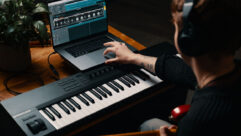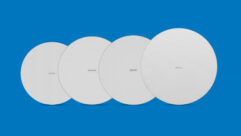
HP mp3220
Apr 1, 2005 12:00 PM,
By Jeff Sauer
Travel projector holds promise for integrators.
Wasn’t it only a couple of years ago that a sub-4lb. projector was a luxuriously lightweight model for the traveling presenter? And wasn’t it a few years before that that conference-room units boasted a high of 2000 lumens of brightness? Today, a small handful of projectors out there fit both descriptions, and it’s a testament to how far forward the technology has moved.
HP’s mp3220 is one of those few: a native XGA-resolution projector that weighs just 3.8lbs. and boasts a brightness specification of 2000 lumens and a full-on/off contrast of 2000:1. And at just $1,799, there’s almost no premium for the small size.
But that’s not what would make the mp3220 interesting to systems contractors, even if the projector is from a reliable, service-oriented company like HP. HP is using a five-segment color wheel that is, at first glance, curious. It adds a yellow section to the red, green, blue, and clear sections of typical DLP business projectors. The result is more vibrant graphical, text, and slide presentations.
The mp3220 comes in a rectangular white chassis that is sleek enough to pack easily into its small carrying bag, which features handy individual pockets for cables. An attached lens cap rotates out of the way but doesn’t come off, so it will never get lost. A cutaway in the unit top gives access to the manual zoom and focus rings, and a standard (if small-buttoned) keypad on the top gives access to HP’s thoughtfully designed menus. There are dedicated buttons for source, auto-sync, and color mode. The mp3200 includes a credit card-sized remote control that has similar navigational arrows but adds mouse functionality, including right and left clicks, to control your presentation computer directly.
Although the mp3220 is bright enough to fill a small conference room, it’s admittedly not targeting fixed installations. It has minimal connectivity options: just a 15-pin, a composite, and an S-Video jack, plus a mini-jack for audio. However, your multimedia computer is likely to be the better solution for audio, as the mp3220 has just a single 1W speaker.
Still, its size and performance would make the mp3220 a very handy unit to move from room to room on either a corporate or educational campus. I measured brightness at 1747 ANSI lumens. That’s lower than HP’s claim of 2000 lumens by a little more than 10 percent. That’s not bad in today’s projector industry, and it would be closer had I not reduced the default brightness for accuracy against a standard pluge. A 77 percent brightness uniformity is a little less impressive — above 80 percent is better — but it’s not a serious issue for the target use.
I did find color temperature to be very consistent across the image, although there was a marked and curious color temperature change of 2000 degrees Kelvin between grays brighter than 50 percent and those less than 50 percent.

Carrying bag for HP’s mp3220 projector.
That’s probably a result of the five-segment color wheel, because the yellow section would likely be “on” for lighter shades and “off” for darker ones.
HP has added that yellow section to the color wheel to increase the vibrancy of yellow and, the company says, the accuracy of pastel colors. Those are the colors that often suffer when the clear white section is added to DLP business projectors for extra brightness. (Projectors oriented toward home theater or video typically have a six-segment wheel with two sections each of red, green, and blue to yield more accurate color.)
As I see it, the “big yellow” section does help overall, but not exactly the way it’s advertised. It’s true that yellow is stronger and less washed out. I also found that visually I perceived improved contrast, presumably because the new yellow section was adding at least some color variation, accurate or not, to other light colors. With bright whites and those discernible other light color shades, the mp3220 certainly does have the ability to make presentation slides and other computer images pleasantly bold.
On the other hand, those non-yellow light colors are not particularly accurate, especially oranges. For example, there are a couple of sunset scenes on Joe Kane’s Digital Video Essentials DVD that might as well be in old black and white TV for all the emotion the mp3220 brings to them. Actually, it’s not that there is no color — as I mentioned above there are more shades of color — it’s just that they are not the kind of colors that can take our breath away in the early evening hours. Imagine a sunset of mostly variations on red and ecru: It just doesn’t come alive without the blazing oranges. Skin tones also tend to be a little pasty, although many viewers might find a lack of redness in a face pleasant, even if nature generally puts it there.
A look at the mp3220’s grayscale range reveals that while overall contrast is good, the actual range of luminance levels is rather limited. I measured full-on/full-off contrast at 1119:1 and 1129:1 with two different meters — much lower than the 2000:1 HP claims, but still good — and 268:1 ANSI checkerboard. However, nearly half the shades of a standard 16-level grayscale pattern are not visible. That’s the same poor grayscale performance you’d get from a typical four-segment color wheel, if not a little worse because, here, the yellow and clear sections make up about 40 percent of the color wheel. However, the yellow does add a little chrominance differentiation, so the appearance is not unpleasant, though it’s not true grayscale.
Overall, it’s better to look at those color shortcomings as tradeoffs, and not bad ones for the intended use. The mp3220 isn’t meant to be a home theater projector, but rather a business presentation model displaying slides and charts in often-bright conference rooms. Business projectors have always put the premium on brightness and contrast, and the mp3220 does the same. However, by adding the yellow segment to the color wheel, it takes a step forward, if a little off-center, toward more vibrant images.
SPECIFICATIONS
Brightness 2000 ANSI lumens
Contrast 2000:1 full-on/off
Native resolution XGA (1024×768)
Configuration 1 DMD DLP (5-segment color wheel)
Light source 200W P-VIP
Lens ~2.4 (wide), ~2.65 (tele); manual focus, manual zoom
Keystone ±16° vertical
Speakers 1W mono
Dimensions (W×H×D) 2.77″×8.27″×9.88″
Weight 3.8lbs.
Accessories Wireless remote, cables, soft carrying case, CD-ROM user’s guide
Warranty 2 years parts and labor (90 days lamp), choice of express exchange or repair
PRODUCT SUMMARY
Company: HP; www.hp.com
Pros: Light weight; good brightness; extra yellow segment of the color wheel improves perceived contrast.
Cons: Light colors besides yellow are not very accurate.
Applications: Business and educational campuses with multiple conference rooms or classrooms.
Price: $1,799










